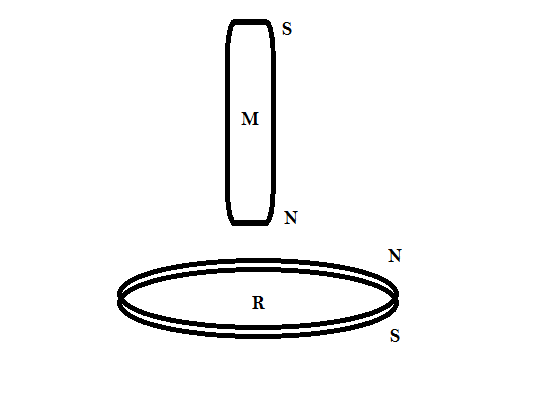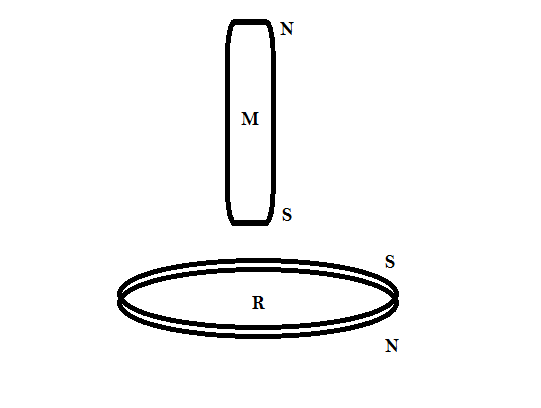
A metal ring is kept horizontally and a magnet bar is dropped through the ring with its length along the axis of the ring. The acceleration of the falling magnet:
A) Is equal to g
B) Is less than g
C) Is more than g
D) Depends on the diameter of the ring and the length of the magnet bar.
Answer
124.5k+ views
Hint: First we should remember that a magnet bar has two poles, namely, the South Pole and the North Pole. And the same type of pole, north-north or south-south repel each other but the different types of two poles of a magnet bar attract each other. We can analyze the above problem with the help of Lenz’s law. Lenz’s law states that the direction of the electric current which is induced in a conductor by a changing magnetic field such that the magnetic field created by the induced current opposes the initial changing magnetic field.
Complete answer:
Step 1: consider the following figure

Let us suppose that the north pole of the magnetic bar is entering first in the metal ring then according to Lenz’s law, that is, the current induced in a circuit due to a change in a magnetic field is directed to oppose the change in flux and to exert a mechanical force which opposes the motion. Therefore the force of repulsion between the ring and the bar will oppose the motion of the bar. It is very important here that in which direction the current is generated because of the magnetic flux change. Thus the bar will slow down when dropped through the ring and the acceleration of the ring will be less than g.
Step 2: Now consider the following figure

Now consider another case when the south pole of the magnetic bar is entering first in the metal ring. Now the direction of the current in the ring will be opposite of the direction of the current when the North Pole was entering first. Therefore the direction of the magnetic fields line will also be reversed. Eventually, the electromagnetic field will be generated and this time the South Pole of the ring and South Pole of the magnetic bar will repel each other. Thus again the bar will slow down while passing through the ring.Thus the acceleration of the magnetic bar will be less than g.
The correct answer is option B.
Note: Magnetic flux is the number of imaginary lines passing through the one unit area in a magnetic field. When a magnetic bar is allowed to go through a coil, pipe, loop, etc. then the magnetic flux forces the free electron in a particular direction. It generates current in the circuit and eventually an electromagnetic effect in the circuit.
Complete answer:
Step 1: consider the following figure

Let us suppose that the north pole of the magnetic bar is entering first in the metal ring then according to Lenz’s law, that is, the current induced in a circuit due to a change in a magnetic field is directed to oppose the change in flux and to exert a mechanical force which opposes the motion. Therefore the force of repulsion between the ring and the bar will oppose the motion of the bar. It is very important here that in which direction the current is generated because of the magnetic flux change. Thus the bar will slow down when dropped through the ring and the acceleration of the ring will be less than g.
Step 2: Now consider the following figure

Now consider another case when the south pole of the magnetic bar is entering first in the metal ring. Now the direction of the current in the ring will be opposite of the direction of the current when the North Pole was entering first. Therefore the direction of the magnetic fields line will also be reversed. Eventually, the electromagnetic field will be generated and this time the South Pole of the ring and South Pole of the magnetic bar will repel each other. Thus again the bar will slow down while passing through the ring.Thus the acceleration of the magnetic bar will be less than g.
The correct answer is option B.
Note: Magnetic flux is the number of imaginary lines passing through the one unit area in a magnetic field. When a magnetic bar is allowed to go through a coil, pipe, loop, etc. then the magnetic flux forces the free electron in a particular direction. It generates current in the circuit and eventually an electromagnetic effect in the circuit.
Recently Updated Pages
JEE Main 2021 July 20 Shift 2 Question Paper with Answer Key

JEE Atomic Structure and Chemical Bonding important Concepts and Tips

JEE Amino Acids and Peptides Important Concepts and Tips for Exam Preparation

JEE Main 2023 (April 8th Shift 2) Physics Question Paper with Answer Key

JEE Main 2023 (January 30th Shift 2) Maths Question Paper with Answer Key

JEE Main 2022 (July 25th Shift 2) Physics Question Paper with Answer Key

Trending doubts
JEE Main 2025 Session 2: Application Form (Out), Exam Dates (Released), Eligibility & More

JEE Main Exam Marking Scheme: Detailed Breakdown of Marks and Negative Marking

The formula of the kinetic mass of a photon is Where class 12 physics JEE_Main

JEE Main 2023 January 24 Shift 2 Question Paper with Answer Keys & Solutions

Learn About Angle Of Deviation In Prism: JEE Main Physics 2025

JEE Main 2025: Conversion of Galvanometer Into Ammeter And Voltmeter in Physics

Other Pages
JEE Advanced Marks vs Ranks 2025: Understanding Category-wise Qualifying Marks and Previous Year Cut-offs

JEE Main Login 2045: Step-by-Step Instructions and Details

Dual Nature of Radiation and Matter Class 12 Notes: CBSE Physics Chapter 11

Electric field due to uniformly charged sphere class 12 physics JEE_Main

Ideal and Non-Ideal Solutions Raoult's Law - JEE

JEE Mains 2025 Correction Window Date (Out) – Check Procedure and Fees Here!




